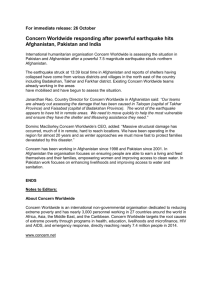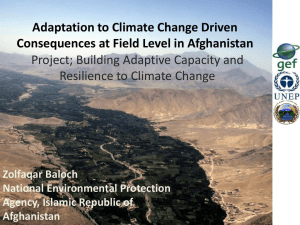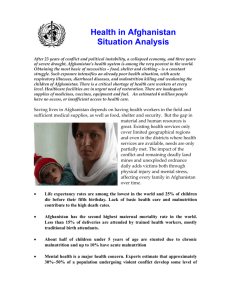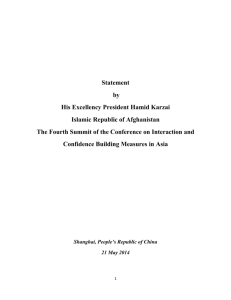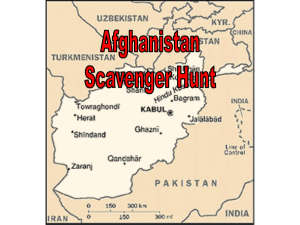China`s Belt and Road Initiative and Afghanistan
advertisement
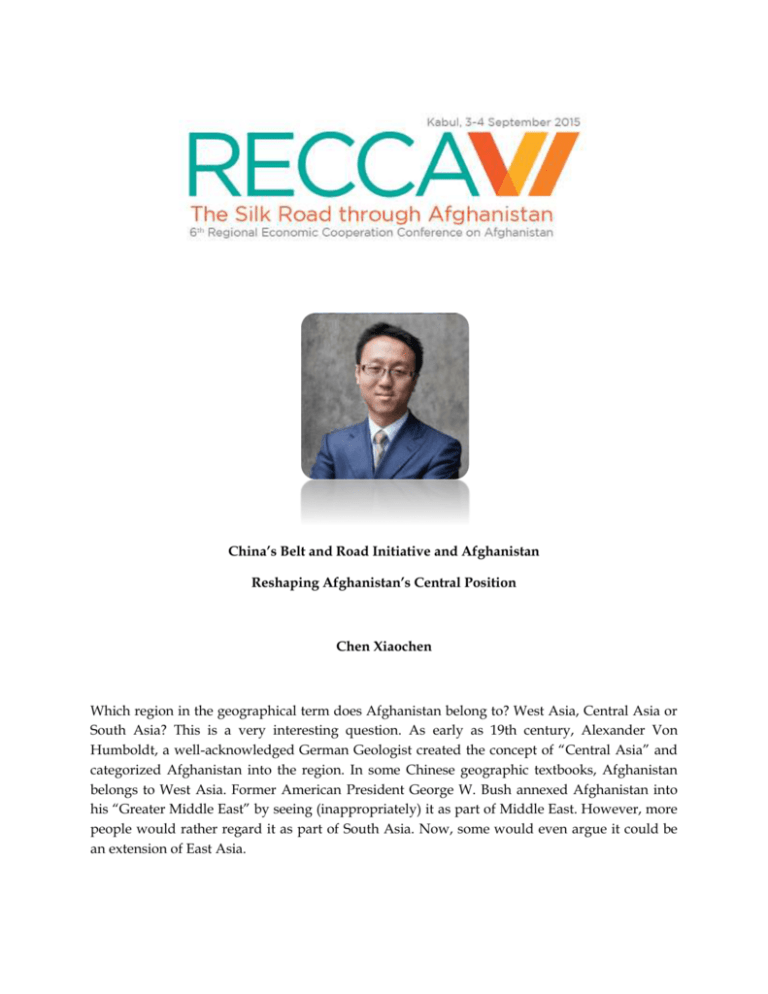
China’s Belt and Road Initiative and Afghanistan Reshaping Afghanistan’s Central Position Chen Xiaochen Which region in the geographical term does Afghanistan belong to? West Asia, Central Asia or South Asia? This is a very interesting question. As early as 19th century, Alexander Von Humboldt, a well-acknowledged German Geologist created the concept of “Central Asia” and categorized Afghanistan into the region. In some Chinese geographic textbooks, Afghanistan belongs to West Asia. Former American President George W. Bush annexed Afghanistan into his “Greater Middle East” by seeing (inappropriately) it as part of Middle East. However, more people would rather regard it as part of South Asia. Now, some would even argue it could be an extension of East Asia. No matter what geographical, cultural and political concerns are behind the different concepts, they all indicate a clear fact that Afghanistan is a landlocked nation located in the central Eurasia Continent, a real “heartland” in this regard. In the past, Afghanistan was once an important center for trade thus enjoyed great prosperity. Among other peoples, ancient Chinese also made contribution to it. In Han Dynasty, Zhang Qian was dispatched as a diplomatic envoy westward in 138 BC. After 13 years of traveling he eventually reached today’s Afghanistan and became the first Chinese who set foot upon this land. Since then, the communication between China and Afghanistan has never been impeded by Pamirs. However, Afghanistan was gradually marginalized in modern times when Afghanistan had been invaded by three global empires - the Great Britain, the Soviet Union and the United States, which brought hardships to Afghani people. After all, great powers rival for its geopolitical importance using their forces. Under this circumstances, “the Central Position” brought turmoil instead of prosperity to this land. Now, instead of military existence, the rising China has launched “Belt and Road Initiative” aiming at economic development rather than territorial intentions. I would expect this initiative will exert Afghanistan’s geographically advantage in a positive way. That also explains why it has been warmly welcomed by Afghanistan among over 60 nations along even beyond the region since it was proposed. I would also suggest that under this initiative Afghanistan is able to make full use of its geographical advantage, reshape its “central place”, improve its economy and promote peace and stability. Belt and Road Initiative and Economic Corridors When Chinese President Xi Jinping visited Central Asia and Southeast Asia in September and October of 2013, he raised the initiative of jointly building the Silk Road Economic Belt and the 21st Century Maritime Silk Road (hereinafter referred to as the Belt and Road), which have attracted close attention from the world. Being different from its literal meaning, the “Belt and Road” is more than one belt and one road. It is a broad initiative of China for economic cooperation across the Eurasian Continent. Some key proposals of this initiative, obviously, can be called “economic corridors”. At least two of them are closely relevant to Afghanistan. One is “China-Central Asia-West Asia” Economic Corridor. Starting from Xinjiang, this corridor overlaps with New Eurasian Land Bridge within China’s territory, and builds a new economic corridor which links Central Asian countries, Iran, Iraq and Turkey up and reaches the Persian Gulf, coast of the Mediterranean and Arabian Peninsula after stepping out of China’s border from Alataw Pass-Khorgos. This corridor is an energy passage in the route where China-Central Asia oil and gas pipelines must pass through. At present, this pipeline is now the longest natural gas pipeline in the world which starts from the border between Turkistan and Uzbekistan at the right bank of Amu Darya and enters into China from Khorgos via Uzbekistan and Kazakhstan. The other major corridor is the China-Pakistan Economic Corridor. Chinese Prime Minister Li Keqiang proposed such vision of jointly building this corridor when he visited Pakistan in 2013. It aims at enhancing China-Pakistan cooperation in the fields of transportation, energy, maritime and so on, as well as advancing the connectivity between these two economies by creating a major economic artery from Kashgar of Xinjiang, China in the north to Gwadar Port of Pakistan in the south. Running through several key hubs of both Silk Road Economic Belt to its north and 21st-Century Maritime Silk Road to its south, China-Pakistan Economic Corridor is a trade route up to 3000 kilometers in its total length with various projects such as railway, highway, oil-gas pipelines and optic cable passageways. Neither of these two economic corridors is limited within some specific geographic sphere as Afghanistan is located in the influential scope of them. In fact, roads in Chinese refer to a broader perspective. China’s Belt and Road Initiative consists five pillars: First of all, policy coordination. For Afghanistan, the precondition of the build-up of Belt and Road Initiative is security cooperation. The specific plans should be jointly decided by Afghans themselves. Moreover, all relevant countries should strengthen their cooperation in the fields such as anti-terrorism and drug control. Further, the role of regional cooperation platforms as Shanghai Cooperation Organization (SCO) should be fully played in order to improve the security situation in Afghanistan and its surrounding regions jointly. Second, facilities connectivity. On the basis of respecting each other's sovereignty and security concerns, countries along the Belt and Road should improve the connectivity and technical standard systems, jointly push forward the construction of international arteries, and form an infrastructure network connecting Afghanistan with other part of Asia. This part will be elaborated specifically in the following sections. Third, unimpeded trade. All relevant countries should improve trade and investment facilitation toward Afghanistan and eliminate trade barriers through tariff reduction so that Afghanistan can play a more significant role in regional and Eurasian trade as logistics efficiency increases and commercial intercourse expands. Advancing cooperation on mineral exploitation is especially vital for Afghanistan as it is rich in resource reserves and possesses vast market demand. Countries should corporately exploit mineral resources in environmental friendly and community sharing approaches to transform its resource potential into development advantage. Fourth, financial integration. Investment is what Afghanistan needs urgently with a missing gap between demand and supply. Several new financial institutions founded or pushed forward by China, such as Asian Infrastructure Investment Bank (AIIB), New Development Bank and Silk Road Fund have potentials to fuel the investment in Afghanistan and this region. This part will be elaborated specifically in the following sections. Last but not least, people-to-people bond. Chinese government has been committed to enhancing people-to-people exchange and communication based on respecting cultural diversity, so as to forge a firm public foundation for regional cooperation. For example, Chinese government will increase personnel training for Afghanistan and expand cultural exchange. Now, I would like to elaborate how the Belt and Road Initiative can help Afghanistan’s reconstruction by enhancing its central geo-economic role through connectivity. Connectivity and Afghanistan’s Central Position For Afghanistan, the top priority of the Belt and Road Initiative is to speed up infrastructure construction and interconnection, which is the cornerstone for extending regional economic and trade cooperation and making Afghanistan a central place for economic activities again. Chinese have an old saying “to be rich, construct a road first”. This has been proved as Chinese experience that good infrastructure would lay a solid foundation for industrialization. It also has spill-over effects socially and culturally: building roads will not only drive the local economy by facilitating trade and production, it will also change people’s life by increasing job opportunities and labor mobility, which will further broaden people’s horizon, reduce extreme thoughts and open possibilities as people travel to and from distant places. Afghanistan enjoys a geo-strategic importance as it connects Central Asia,South Asia and Middle East.Countries in or around this region such as India, Pakistan, Iran, Uzbekistan, Turkmenistan, Tajikistan and China are being involved in construction of transportation and energy strategic passage to and through Afghanistan. In general, the construction of strategic passage in Afghanistan has important implications: it is helpful to Afghanistan's communication with outside world and its stability. With the rising demand from East Asia and South Asia, and rapid increase in commercial import and export, connecting Afghanistan and further connecting across the entire Eurasia has become a shared vision. Afghanistan will benefit from it to a large extent by taxation, employment, transit fees, and energy shares. For example, the proposed TurkmenistanAfghanistan-Pakistan-India (TAPI) natural gas pipeline is expected to create 3,000 to 5,000 job opportunities, 433 million transit fees, and 14 million cubic meters of natural gas for import if it is built. More importantly, the construction of transportation energy passage will lay a solid foundation for industries such as mining, in turn create more sustainable demands for an energy supply network. Railways have irreplaceable value in modern transportation system for its high cumulative and stable capacity. But it was not until the end of 2011 when the 75km Afghani-Uzbekistani railway opened to traffic that Afghanistan finally started railroad operation and walked in a new era of heavy haul cross-border modern transportation network. Shortly after that on January 2012, Afghanistan signed an economic and technology cooperation agreement with Tajikistan and agreed to construct a railway connecting the two countries. In addition, Afghanistan also has agreed to construct a railway passage toward Turkmenistan. By far Chinese enterprises have been involved in Afghani domestic railways. In September 2011, China Metallurgical Group Corporation signed a contract with Afghani government and agreed to construct hundreds of miles of railway that links Anyak and other copper mines in the central, east and northern border area of Afghanistan. Once it is completed, it will transport mineral products and carry passengers. Besides, a China-Iran railway passing Afghanistan is also in the blueprint, for which Afghani Ambassador to China openly expressed his welcome to Chinese companies to bid. Last, despite of many difficulties on the ground, Afghanistan also has suggested China to build a China-Afghanistan railway directly through Wakhan Corridor. Road transportation is a more realistic approach at present. There are three main arteries for Afghanistan to connect with other countries: the southern line – to Karachi as the main trade passage; the western line – to Bandar Abbas; the northern line – to Hairatan and finally Kashgar. The overland Silk Road may rehabilitate the northern line with technology to overcome the difficulties in high mountainous area in winter, and then boost the trade through Uzbekistan to Xinjiang, China, while the maritime Silk Road is expected to enhance the capacity of Pakistani ports to accelerate the cargo transportation. China Railway 14th Construction Bureau Co., Ltd has contracted for part of Jalalabad Highway rehabilitation project from Kabul eastward to the border area with Pakistan. Apart from road transportation, there are also several main energy passages through Afghanistan. Located between energy-rich Central Asia and Middle East and energy-short South Asia and China like a crossing, Afghanistan enjoys huge geo-energy potentials. Therefore, building an energy passage through Afghanistan linking energy supply and consumption has become a shared vision. Afghani people along the energy passage can benefit from transit fees. After Chinese National Petroleum Corp. (CNPC) was authorized the drilling right in Armudaliya in 2011, it planned to build a natural gas pipeline linking Turkmenistan, Tajikistan, Afghanistan, and China (TTAC). This proposed project has received positive response from Afghani side, although security is still the obstacle for further developing. Electricity is essential to the social welfare and information access of the people. However, electricity is still in shortage in Afghanistan, and highly reliant on import. It cannot meet the needs of households, let alone production sectors. Here I would like to propose an “electricity corridor”, including an ultra-high voltage (UHV) transmission network linking Xinjiang, China to Afghanistan and Pakistan. On one hand, Xinjiang has abundant supply of wind power, solar power and coal production which can be transformed into electricity. On the other hand, Afghanistan is in need of electricity. It also has potentials in solar energy productions. Thus, there would have been a united power grid alike the Northern European grid despite of the security problems and high costs for equipment maintenance. This will even power the planned industrial park blocked by the lack of grid. Considering the problems on the ground, it still has potential in future if the lines and towers can be protected against attacks. Although China has potentials in participating in infrastructure and connectivity in Afghanistan, it is not proper to see the Belt and Road Initiative as merely China’s proposal and projects. In fact, Chinese government has officially made it clear that it welcomes countries to accelerate the interconnection in this region and it is willing to participate in the related construction under Silk Road Economic Belt and other cooperation frameworks to promote Afghanistan’s local transportation and logistics. I view this as a wise position. China should not and will not reject other countries’ efforts in the construction of infrastructure. On the contrary, China should try to find a method to connect these plans raised by various parties, and to promote regional openness and inclusiveness. Various silk road initiatives can work together well. Among them, I would in particular suggest that the United States should consider seriously coordinating its New Silk Road Plan with China’s Belt and Road Initiative. In fact, any plan, as long as it could promote the connectivity in Afghanistan and this region, improve economic development and peace and stability, should receive support, no matter from which country. China’s interests lie in a stable and peaceful Afghanistan and region, no matter which countries help it happen. Investment through Cooperation Investment is the key element for economic growth, and social stability in turn. I advocate that we should put investment on the top element in reconstructing Afghanistan. Related countries should work together to enhance investment into this country. International institutions such as AIIB should play a positive role in the process. In addition, some new funds of commercialized operation such as the Silk Road Fund can also seek investment opportunities in Afghanistan. Apart from serving as an energy passage, Afghanistan is also rich in energy and natural resources itself. It is estimated by Energy Intelligence Agency (EIA) that Afghanistan has approximately 1 trillion dollars worth of mineral resources and almost none has ever been exploited. Reconstructing Afghanistan heavily relies on its mining industry. Afghanistan’s former Minister of Mining Industry once expressed to media that by the year of 2024, Afghanistan’s metals and oil production would take up 45% of Afghanistan’s entire Gross Domestic Production (GDP). However, exploiting oil and mining requires consistently heavy investment in the long term, which is what Afghanistan is mostly lack of nowadays. It is reported that in the past decade, foreign direct investment (FDI) has reached $271 million on average annually, but the figure is far from enough. And it is no doubt that all projects must be conducted in environmental friendly and community sharing approaches to make a sustainable and inclusive growth. At present, China is the biggest investor as a country in Afghanistan with its two largest investment projects in oil and mining industry. In March 2011, CNPC established a joint venture with Watan Group and exploited 3 fields at Amu Darya Basin jointly. In less than one year after signing the contract, the oil production testing station operated successfully. This was the first time that Afghanistan’s oil field officially started production in the past three decades. However, the tough security situation still impedes the project. Moreover, the construction of infrastructure requires substantial and sustainable investment and financial aid. In March 2015, Afghani President Ashraf Ghani stated in the speech that China is one of the biggest financial supporters to Afghanistan in the past ten years, and “China provides voluntary supports to Afghanistan and all went entirely to the construction of infrastructure.” Apart from bilateral economic cooperation, I would suggest that the countries including China should enhance their investment to Afghanistan by taking full advantage of the existing multilateral cooperation mechanisms, and by pushing forward the building of the Belt and Road and to promote the development of regional cooperation on Afghanistan. First, we should improve the investment for infrastructure by institutions such as Asian Development Bank (ADB) and Asian Infrastructure Investment Bank (AIIB). According to a World Bank report, Afghanistan requires financial funding more than 7 billion USD per year after 2014. But according to the ADB datas, the loans it provides to Asia in 2013 as a whole only amounts to 21 billion dollars. Obviously, there is a huge missing gap between the needs for investment and supplies. By far, Afghanistan has still not joined AIIB. However, it is highly feasible that AIIB will fund the infrastructure investment in Afghanistan in future. Second, we should make the economic use of existing institutions viewed more as political ones. The countries involved should enhance the role of multilateral cooperation mechanisms in economic development such as SCO, Conference on Interaction and Confidence-Building Measures in Asia (CICA), Asia-Europe Meeting (ASEM), Asia Cooperation Dialogue (ACD), and Central Asia Regional Economic Cooperation (CAREC) to strengthen communication with relevant countries to work together in helping Afghanistan, and attract more countries, institutions and other entities to participate in the Belt and Road Initiative. However, it is obvious that security is still the dilemma. In the long run, investment will ultimately lift people out of poverty, and then reduce the incentives toward terrorism and turmoil. But security tension still prohibits investments in short term. To work it out, an Afghani-led domestic political talk should be enhanced, and one of its aims could be protecting foreign investment. Conclusion China’s Belt and Road Initiative could work for Afghani people in many ways, including providing electricity, increasing trade, creating jobs, leaving transit fees for energy passage, connecting this land with outside world, and encouraging more investment. Upheld by five pillars, Belt and Road Initiative will in particular strengthen the reconstruction of this country by enhancing infrastructure and attracting investment in a cooperative and inclusive way. There are various initiatives raised by different countries and institutions; however, they can work together for Afghanistan’s peace and prosperity, which is of the interests for its neighboring countries. In all, although security situation still cast a real tension on the ground, initiatives for economic development especially in infrastructure and investment can be designed for alleviating the tensions in the long run and at root, and reshaping Afghanistan’s central place in Eurasia.


